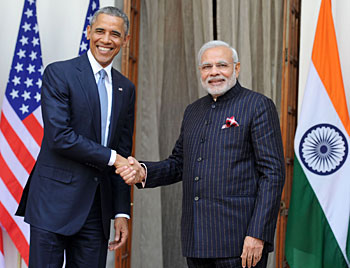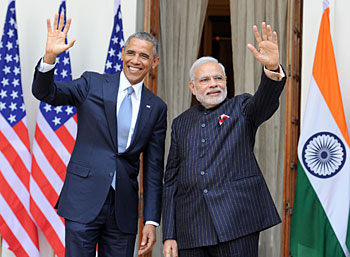INDIAN ARMED FORCES CHIEFS ON
OUR RELENTLESS AND FOCUSED PUBLISHING EFFORTS

SP Guide Publications puts forth a well compiled articulation of issues, pursuits and accomplishments of the Indian Army, over the years

I am confident that SP Guide Publications would continue to inform, inspire and influence.

My compliments to SP Guide Publications for informative and credible reportage on contemporary aerospace issues over the past six decades.
- Prime Minister witnesses 'Bharat Shakti' – a Tri-Services Firing and Manoeuvre Exercise in Pokhran, Rajasthan
- Interim Defence Budget 2024-25 — An Analysis
- Union Defence budget 2024
- Indian Army: In quest of greater firepower and policy recommendations for gaps
- Indian Army Annual Press Conference 2024
- 6G will transform military-industrial applications
US India strategic romance


Prime Minister, Narendra Modi with the US President, Barack Obama, at Hyderabad House, in New Delhi on January 25, 2015.
He came, he saw, he conquered. The three day (from January 25 to 27) visit of the US President Barack Obama as a guest of honour on India's Republic day was an overwhelming success from the perspective of deliverables. The visit was not only high on symbolism but also highly result oriented. From nuclear to defence and in economic and strategic arena , the visit has not only bilateral but also international ramifications. Significantly, the Obama-Modi summit esulted in not one but three joint declarations. They were: Shared effort — progress for all; India —US Delhi Declaration of Friendship and the US India Joint strategic vision for the Asia —pacific and Indian Ocean region.
The whole world, not to speak of China and Pakistan only, looked with awe the level of understandings reached between the two world's most powerful democracies. Hence they have issued strange reactions including Obama-Modi romance aimed at denting Sino-Indian relations. The Pakistani Foreign Ministry said that implementing the 2008 civil nuclear deal "for political and economic expediencies would have a detrimental impact" on the stability of nuclear deterrence in South Asia. They also objected to US support for India's membership in the Nuclear Suppliers Group (NSG) under a plan that would exempt New Delhi from some of the group's export rules.
First US President at Republic Day
Since it was Obama's second visit in his presidency and first by an American President to attend the Indian Republic Day, the Modi invite has been largely viewed by many as Modi's over enthusiasm in developing rapport with world's most powerful man and also his effort to enhance his political profile in domestic politics. The manner in which the two leaders have removed the impasse in nuclear energy cooperation has surprised Indian and international political pundits alike. The decision to expand the range and scope of defence cooperation and its period by another ten years has not surprised any one as it was largely on the cards and in line with the ongoing cooperation in defence and strategic arena.
Malabar Exercise
The decision to upgrade the Malabar naval exercise has attracted the attention of China which has warned India that US wants India to split from China and Russia. India and US are presently conducting bilateral naval exercise under the Malabar series since the early 90s. India did convert this to a multilateral exercise in 2007 when three other like-minded nations Singapore , Australia and Japan were invited. China had then reacted strongly and India developed cold feet. However in the background of China's continued offensive against India in international nuclear regimes and in South China Sea, besides increased Chinese aggressiveness vis a vis India on the 4000 Kms LAC, India's decision to let others join in the Malabar maritime construct is very significant.
India's role in Asia-Pacific
This agreement has been announced along with the declaration in the Joint Statement that both countries recognize the role each play on promoting peace, prosperity and stability and security in the Asia-Pacific and Indian Ocean Region. India's 'Act East Policy' and the US Re-balance to Asia provides opportunities for India, the USA and other Asia—Pacific countries to work closely to strengthen regional ties. While addressing the Town Hall meeting at Siri Fort, President Obama talked of India playing greater role in the Asia Pacific region and the interests of both countries in maintaining peace and stability and freedom of navigation in the South China Sea.
Energized nuclear cooperation
These averments by the two leaders have set the tone and the future direction of the strategic partnerships which will be energized by the nuclear cooperation. The agreement in nuclear sector, details of which has not yet been publicly shared, has raised the confidence levels of both the sides of raising the level of strategic partnerships. This was lying mostly idle since 2008 when US India Civil Nuclear energy deal was signed. India, two years later, enacted the Civil Nuclear Liability law placing the entire onus for any nuclear accident on the suppliers of nuclear equipments rather than the operators of the nuclear plants. The liability amount was unlimited and for unlimited period, which had irked the American nuclear suppliers. This was withholding the nuclear cooperation plans with other civil nuclear powers. However, the Modi government was able to seal a deal with the American negotiators, which Indian officials claimed only within the confines of the Indian Civil Nuclear Liability Law. President Obama himself called it a "breakthrough". The two sides resolved key hurdles pertaining to the financial liability of the suppliers of nuclear reactors in the event of an accident and the tracking of fuel supplied by the US and other countries for its proposed nuclear plants.
Commenting on the achievement, Indian Foreign Secretary Sujatha Singh said, "We have broken the logjam of the past few years. We have reached an agreement. The deal is done." From the US side the Deputy National Security advisor Ben Rhodes said the understandings on the civil nuclear programme resolves the US concerns on both tracking and liability. "In our judgement , the Indians have moved sufficiently on these issues to give us assurances. It will still be for the US companies to assess the market and decide whether to partake in India's nuclear programme or not." Neither country needed to take legislative action to complete the agreements reached between the two leaders.
Sujatha Singh said "The liability provisions and administrative arrangements finalized under 123 act ( tracking) are consistent with our bilateral legal arrangements and contracts and IAEA safeguards and international laws and obligations."
Moving towards commercial cooperation
Prime Minister Modi declared that the "nuclear deal between the two countries is moving towards commercial cooperation, consistent with our law, our international obligations . The civil nuclear agreement was the centre piece of our transformed relationship, which demonstrated new trust. It also created new economic opportunities and expanded our option for clean energy."
Pathfinder projects
The removal of impasse in nuclear arena boosted the defence cooperation agenda , as the two countries renewed an enhanced Defence Framework Agreement for the next ten years and identified four key " pathfinder projects" for joint development and production including the next generation Raven mini hand held UAV besides specialized kits for Lockheed Martin made C-130 military transport aircraft Super Hercules. The two countries will also set up a Working Group to explore aircraft carrier technology besides design and development of jet engine technology. Under this rubric the two countries will also work on mobile electric hybrid power source and Uniform Integrated Protection Ensemble Increment 2. The 2005 first defence framework agreement was signed in Washington by the then Defence Minister Pranab Mukherjee and his US counterpart in the previous George W.Bush administration, Donald Rumsfeld.
Modi said "We have also decided to take our growing defence cooperation to a new level. We have agreed, in principle, to pursue co-development and co-production of specific advanced defence projects." Modi hoped that this will help advance Indian domestic defence industry and expand the manufacturing sector in India.
Re-balancing Asia
The concern in US strategic circles is quiet visible. During a Congressional hearing one retired US General advised the US administration that "While our efforts in the Pacific to keep positive relations with China are well and good, these efforts must be paralleled by a policy to build the counterbalance if China continues to expand its bullying role in the South China Sea and elsewhere. That counterbalance must deny China veto power over territorial, security, and economic conditions in the Pacific, building support for our diplomatic efforts to maintain stability and economic prosperity so critical to our economy." Mattis said this in response to a question, according to news agency PTI . This explains the confluence of "Re-balancing Asia Policy" of US and "Act East policy" of India in the Asia pacific region.
Reporting on the Congressional hearing PTI quoted General John M Keane as saying that China's continuing economic growth has fuelled a major conventional buildup that is beginning to shift the local balance of power in its favour. "As a result, Beijing has been emboldened to act more assertively toward its neighbours, especially in expanding its territorial claims which include not only Taiwan but also most of the South China Sea islands and Japan's Senkaku islands."
General Keane in his assessments of China's aggressive designs said "China has embarked on a strategy of regional domination at the expense of US interests as a Pacific nation and decades of partnership with allied countries in the region." Therefore, Gen Keane called for developing a regional strategy with US allies to counter China's desire for dominant control and influence.
Clearly, the mood in Washington and New Delhi is anti- China, though they are far from officially acknowledging this. Hence, the Obama- Modi summit has given birth to the possibilities of a new alliance in the Asia- pacific region. It's progress will depend on the regional cooperation among the affected parties like Japan, Vietnam, Philippines, South Korea etc. The more they come together in the face of a more aggressive China greater will be the urge to deepen India US defence and strategic partnerships.





